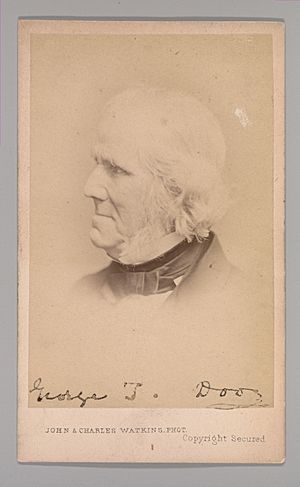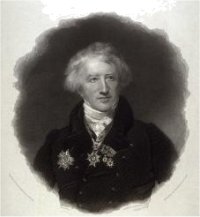George Thomas Doo facts for kids
Quick facts for kids
George Thomas Doo
|
|
|---|---|
 |
|
| Born |
George Thomas Doo
6 January 1800 London
|
| Died |
13 November 1886 (aged 86)Sutton, London
|
| Nationality | British |
| Occupation | Engraver, Historical engraver of Queen Victoria |
| Years active | 1800-1886 |
George Thomas Doo (born January 6, 1800 – died November 13, 1886) was a talented British engraver. He was known for creating detailed pictures by carving designs onto metal plates. He even worked for important people like King William IV and Queen Victoria!
Early Life and Training
George Thomas Doo was born in Southwark, London, in 1800. He learned his engraving skills from a famous teacher named Charles Heath. In 1825, George traveled to Paris, France. There, he continued to study art and drawing. He learned how to draw from real life, which means drawing people or objects as they actually appear.
After his studies, George shared his knowledge with others in England. He taught several students, including William Duffield and William Thomas Roden.
Working for Royalty
George Doo became very skilled at his craft. In 1836, he was given a special title: Engraver in Ordinary to King William IV. This meant he was the official engraver for the King! Later, he also became the official engraver for Queen Victoria. During this time, he often worked for a well-known art dealer named Francis Moon.
In recognition of his talent, George Doo became a member of the Royal Society in 1851. This is a very old and respected group for scientists and artists. He also became a Royal Academician in 1857. This means he was elected to the Royal Academy of Arts, a leading art institution in Britain.
George Thomas Doo passed away in Sutton, Surrey, in 1886, at the age of 86.
Famous Engravings
George Doo created many beautiful engravings throughout his life. His first published work in 1824 was a picture of Prince Frederick, Duke of York and Albany. This was based on a painting by Thomas Lawrence.
Some of his most famous engravings include:
- The Combat (1848): This detailed engraving was based on a painting by William Etty.
- "Knox preaching before the Lords of the Congregation": This work was created after a painting by David Wilkie.
- "Italian Pilgrims coming in sight of Rome": This engraving was inspired by a painting by Eastlake.
- "The Infant Christ": This was based on a famous painting by Raphael.
- "Ecce Homo": This engraving was created after a work by Correggio.
One of his most challenging projects was the 1864 engraving of "The Raising of Lazarus." This amazing piece, based on a painting by Sebastiano del Piombo, took him eight years to complete! It shows how dedicated he was to his art.


